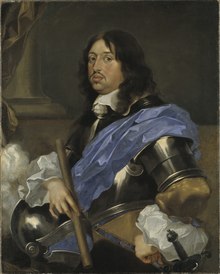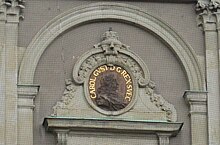Charles X Gustav
| Charles X Gustav | |
|---|---|
 Portrait by Sébastien Bourdon | |
| King of Sweden Duke of Bremen and Verden | |
| Reign | 6 June 1654 – 13 February 1660 |
| Predecessor | Christina |
| Successor | Charles XI |
| Born | 8 November 1622 Nyköping Castle, Sweden |
| Died | 13 February 1660 (aged 37) Gothenburg, Sweden |
| Burial | 4 November 1660 |
| Spouse | |
Catherine of Sweden | |
| Religion | Lutheran |
| Signature | |

Charles X Gustav, also Carl Gustav (
His numbering as Charles X derives from a 16th-century invention. The Swedish king Charles IX (1604–1611) chose his numeral after studying a fictitious history of Sweden. This king was the fourth actual King Charles,[3] but has never been called Charles IV.
Heir presumptive
In his early childhood, raised in the Swedish court alongside his cousin
Early days as king

Charles Gustav was crowned on 7 June 1654, the day after his cousin Christina abdicated.
Second Northern War (1655–1660)
War in Poland-Lithuania

On 10 July 1655, Charles X left Sweden to engage in a war against the

Meanwhile, Charles X Gustav pressed on towards Kraków, which the Swedes captured after a two months' siege. The fall of Kraków followed a capitulation of the Polish Royal armies, but before the end of the year a reaction began in Poland herself. On 18 November 1655 the Swedes invested the fortress-monastery of Częstochowa, but the Poles defended it and after a seventy days' siege the Swedish besiegers had to retire with great loss. This success elicited popular enthusiasm in Poland and gave rise to a nationalistic and religious rhetoric concerning the war and Charles X. He was depicted as tactless and his mercenaries barbaric. His refusal to legalize his position by summoning the Polish diet and his negotiations for the partition of the very state he affected to befriend, awoke a nationalistic spirit in the country.[4]
In the beginning of 1656 King John II Casimir returned from exile and the reorganised Polish army, increased in numbers. By this time Charles had discovered that he could more readily defeat the Poles than conquer Poland. What is described as his chief object, the conquest of
Charles's retreat from Jarosław to
War on Denmark–Norway

Labiau involved an essential modification of Charles's Baltic policy; but the alliance with the elector of Brandenburg had now become indispensable for him on almost any terms. The difficulties of Charles X in Poland are believed to have caused him to receive the tidings of the Danish-Norwegian declaration of war on 1 June 1657 with extreme satisfaction. He had learnt from Torstensson that Denmark was most vulnerable if attacked from the south, and he attacked Denmark with a velocity which paralysed resistance. At the end of June 1657, at the head of 8,000 seasoned veterans, he broke up from Bromberg (
March across the Belts

On 28 January 1658, Charles X arrived at
On 17 July he again landed on Zealand and besieged Copenhagen with its king
Estates in Gothenburg
Charles X consented to reopen negotiations with Denmark, at the same time proposing to exercise pressure upon his rival by a simultaneous winter campaign in Norway. Such an enterprise necessitated fresh subsidies from his already impoverished people, and obliged him in December 1659 to cross over to Sweden to meet the estates, whom he had summoned to Gothenburg. The lower estates protested the imposition of fresh burdens, but were persuaded by Charles.[8]
Illness and death
Soon after the estates opened on 4 January 1660, Charles X Gustav fell ill with symptoms of a cold. Ignoring his illness, he repeatedly went to inspect the Swedish forces near Gothenburg, and soon broke down with chills, headaches and
On 12 February, Charles X Gustav signed his
Family

Charles X Gustav had only one legitimate child by Hedwig Eleonora of Holstein-Gottorp: his successor Charles XI[11] (1655–1697, reigned 1660–1697).
Before his marriage, his mistress
There are credible theories suggesting that Charles Gustav, before marrying Hedwig Eleonora (but not after), also sired several more children of whom some names are known:
Sources
References
- ^ Paul Meijer Granqvist in Carl X Gustaf "den förste pfalzaren Askerbergs, Stockholm 1910 pp. 56–57
- ^ Kontljarchuk, A. (2006). In the Shadows of Poland and Russia: The Grand Duchy of Lithuania and Sweden in the European Crisis of the mid-17th Century. JSTOR. ISBN 91-89315-63-4.
- ^ Article Karl in Nordisk familjebok
- ^ a b c d Bain 1911, p. 927.
- ^ Granlund 2004, p. 57.
- ^ Granlund 2004, pp. 56, 58.
- ^ Bain 1911, pp. 927–928.
- ^ a b c d Bain 1911, p. 928.
- ^ Asmus & Tenhaef 2006, p. 59
- ^ a b Asmus & Tenhaef 2006, p. 60
- ^ Granlund 2004, p. 56.
- ^ Ulf Sundberg in Kungliga släktband ISBN 91-85057-48-7 pp. 123–124 & 278
- ^ Sixtus Bolom in Tajemství Jankovských z Vlašimi a na Bítově ISBN 978-8072685271 p. 91
Bibliography
- Asmus, Ivo; Tenhaef, Peter (2006). "Die Trauerfeier an der Universität Greifswald am 11. Mai 1660 für Karl X. Gustav von Schweden. Historische und rhetorische Aspekte". In Walter Baumgartner (ed.). Ostsee-Barock. Texte und Kultur. Nordische Geschichte (in German). Vol. 4. Berlin: LIT Verlag. pp. 59–84. ISBN 978-3-8258-9987-5.
- Englund, Peter (2003). Den oövervinnerlige : om den svenska stormaktstiden och en man i dess mitt (in Swedish). Stockholm: Atlantis förlag. ISBN 978-9174867206.
- Granlund, Lis (2004). "Queen Hedwig Eleonora of Sweden: Dowager, Builder, and Collector". In Campbell Orr, Clarissa (ed.). Queenship in Europe 1660–1815: The Role of the Consort. Cambridge University Press. pp. 56–76. ISBN 0-521-81422-7.
Attribution
- This article incorporates text from a publication now in the public domain: Bain, Robert Nisbet (1911). "Charles X., king of Sweden". In Chisholm, Hugh (ed.). Encyclopædia Britannica. Vol. 5 (11th ed.). Cambridge University Press. pp. 927–929.
External links
- . New International Encyclopedia. 1905.
- . The American Cyclopædia. 1879.
